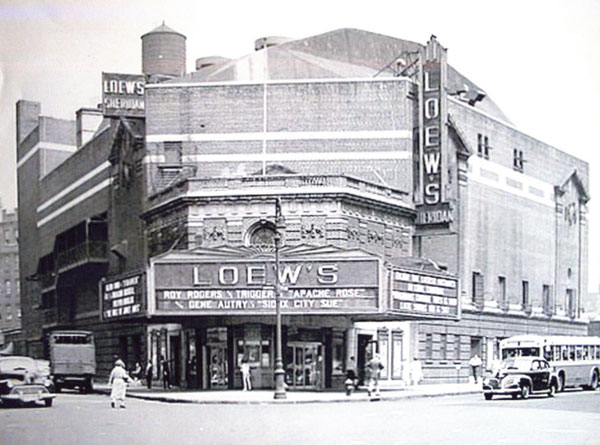
BY CAROL GREITZER | Do you know what 46 Greenwich is? Well, you’re not alone. It’s the temporary (we hope) name of the new park at the triangle formed by Greenwich and Seventh Aves. at W. 12th St. Villagers tend to refer to it as St. Vincent’s Park or St. Vincent’s Triangle, or some such variation, while a group favors AIDS Memorial Park.
Actually, most New York parks have a geographical identity or are occasionally named after a particular person. So, with that in mind, when the subject came up recently, I suggested, somewhat facetiously, that we name it the Loew’s Sheridan Park after the late, lamented movie palace that once occupied the site and has been memorialized in a famous Hopper painting.
Hold that thought. I’m skipping ahead a week or so to when I was looking for a light, entertaining movie on TV. While I was hoping for something in the “When Harry Met Sally” vein, the only thing that seemed even remotely interesting was a film about the Dreyfus Affair. It turned out it was not the famous “Life of Emile Zola,” with Paul Muni, but an English film featuring mostly British actors, though Dreyfus himself was played by Jose Ferrer.
I was half catching up on some reading and half watching the screen, when suddenly a new character appeared, someone named Georges Clemenceau.
Clemenceau! I experienced one of those light bulb-exploding moments. I recalled that there had been a plaque honoring the World War I French prime minister on an outer wall of the theater — I think on the Seventh Ave. side near 12th St., marking the spot where he had lived for a few years. In fact, according to the New-York Historical Society, Clemenceau lived at 212 W. 12th St., one of the buildings demolished to construct the Loew’s Sheridan.
Meanwhile, back on my TV screen, the sensational espionage story was unfolding, revealing that the future head of France had played a key role in the world-famous (perhaps infamous would be more accurate) Dreyfus Affair. My curiosity was aroused. I wanted to learn more about this man. So naturally I googled him and did other researcch…and here’s what I found.
Born in 1841, the young Clemenceau published numerous leftish political articles and once served about 10 weeks in jail for these activities. It was when the regime of Napoleon III began sending people to Devil’s Island for similar offenses that Georges concluded that discretion was the better part of polemical writings. In other words, he decided that this might be a good time to skip town and visit the United States.
Indeed, it turned out to be a great time, an interesting and exciting time, it being 1865, the year the Civil War ended. Clemenceau spent time in New York and New England, teaching and possibly practicing medicine (for somewhere in his busy young life he had become a doctor). He enjoyed our freedom of speech so much, he apparently considered emigrating.
As we know, he didn’t go that far, but he did marry a young American woman, Mary Eliza Plummer, a former student. The marriage did not last long, but long enough to produce three sons.
Back in France, Clemenceau embarked on a political career and continued publishing radical newspapers, leading to his pivotal involvement in the Dreyfus Affair. As owner of L’Aurore, a Paris daily, Clemenceau published Zola’s famous “J’Accuse,” splashing it across the entire front page. In fact it was he, Clemenceau, who suggested “J’Accuse” as the title of the piece, an open letter to the president of France.
The article launched the massive campaign that eventually freed and exonerated Dreyfus, after first virtually dividing the country into Dreyfusards and antis. Among the more than 3,000 pro-Dreyfus intellectuals, many enlisted by Clemenceau, were Marcel Proust, Anatole France, Claude Monet, Guillaume Apollinaire and Sarah Bernhardt.
Clemenceau also wrote hundreds of articles deploring anti-Semitism and supporting Dreyfus. Later he was twice elected premier of France and served as chairperson of the post-war peace treaty meetings.
While I am certainly not suggesting that our new park be named for him, I do want to restore and acknowledge — even amplify — Clemenceau’s presence here, not only in light of the role he played in the Affair, but especially in light of today’s rise of anti-Semitism in France, where the seriousness of the situation is causing large groups of people to emigrate to Israel. Personally, as co-chairperson of the W. 12th St. Block Association, I’m thrilled to learn that 150 years ago, Clemenceau lived right here on 12th St. I hope we restore our recognition of his achievements and honor his accomplishments right here in the park.
Furthermore, if anyone has information as to what happened to the old plaque, please come forward and let us know its whereabouts.
An interesting sidebar reveals a totally different side of Clemenceau, the man. He greatly admired all the impressionists, but Claude Monet was a special friend. The artist was starting to lose his sight late in life, making it difficult for him to see colors properly and thus affecting his painting. Clemenceau, in his role as doctor, persuaded Monet to undergo cataract surgery. The operation improved his vision, the colors came back, and Monet’s beautiful water lilies multiplied.

















